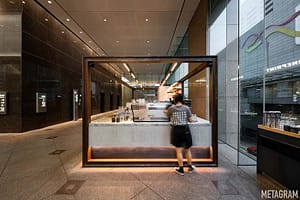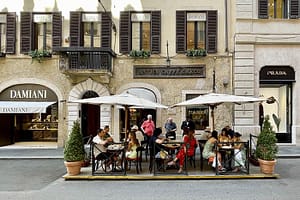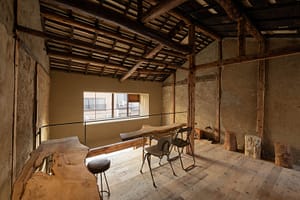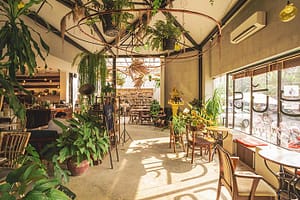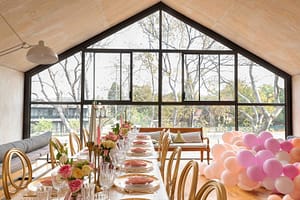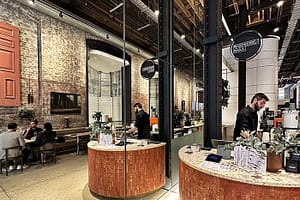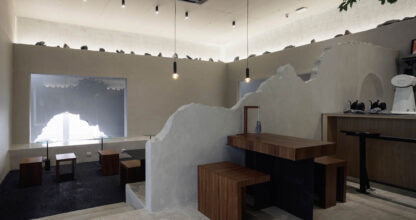Harudot / Chonburi / IDIN Architects Thailand
The genesis of Harudot stems from a collaboration between the Nana Coffee Roasters brand owner and a landlord with a passion for plants with unique forms, culminating in a harmonious fusion of coffee culture and botanical aesthetics.
Architecture and Interiors by IDIN Architects
Landscape design by Youkubdin
Constructed by Wimutti Construction Limited Partnership
Photography by DOF Sky | Ground





Conceptual Framework: Symbolism and Identity
Harudot is a stand-alone café in Chonburi, a famous beachside town in Thailand. The name “Haru” translates to “Spring” in Japanese, referring to “new beginning” and “growth” while “Dot” symbolizes a “starting point”. The two main requirements for this cafe are to, firstly, design a “destination” with an interesting experience that is able to attract visitors, and secondly, to include the landlord’s identity into the design in order to signify this unique collaboration.
To explore Harudot and cafes worldwide see bestcafedesigns.com. A top 100 architectural blog and global directory of cafes and cafe professionals. For more Thailand or asian cafe designs, read more here.





IDIN Architects Architectural Vision for Nana Coffee Roasters: Integrating Nature
IDIN architects chooses to focus on the concept of new beginning and growth by including the trees into the heart of the design. Here, a bottle tree (baobab) has been placed in an inner court where the gable form of the architecture is pulled apart to allow for its growth towards the sky. Thus, making it appears as if the seed of the baobab has been planted long before and grew out through the architecture as time passes.








Design Aesthetics: Japanese Inspiration
The cafe brand’s identity is strongly inspired by Japanese culture, hence, the architect interprets this as humble simplicity but with attention to details. This is represented through the exterior, using three simple gable forms in black color for a subtle look that contrasts with the natural warm pine wood walls of the interior space. As visitors enter the cafe through the gable, the space morphs and bends with curves as it leads guests further into the cafe where the space becomes more dynamic and memorable.





Spatial Organization: Human Scale
The building is separated into smaller masses to make it more human-scale, which established different zones such as the bar, coffee drinking zone, a lounge, a meeting room and the restrooms. The giant gable roof form of each mass is pulled apart at certain parts, allowing the tree to penetrate through a void to the sky creating a semi-outdoor space underneath.





These voids also resulted in an interesting curved form which added movement and dynamic to the architecture. The voids allow for rainfalls and sunlight to enter into the semi-outdoor court, maintaining a connection with nature despite the enclosed walls. These opening features continue into the interior space where instead of actual voids, they are enclosed with Barrisol stretch ceilings that help diffuse the lighting inside, creating a warm softly lit space. The Barrisol ceiling also echoes with the actual open voids in the courtyard, visually and conceptually connecting both spaces into one entirety.



Ribbon Seating Elements: Engaging Experiences
The seating arrangement is designed to be continuous like a ribbon, wrapping around the interior space to create continuity whereas the height of these counters differ to suit the different functions and uses. The outdoor seating is made from resin mixed in with coffee beans grounds, rice and leaves to tide in with the coffee theme.




Detailing and Customization
The attention to details at Harudot extends to the graphic elements as the custom-designed fonts and signage which has been inspired from circular dots and the spring season. The floor is terrazzo and the separation in the material is necessary, therefore the architect specifically designed the floor separations to be circular with insertions of embedded quotes and words that lead to different functions in the cafe. Another playful element includes the flower petals pattern in the terrazzo floor, radiating outward as if they have fallen from the actual trees. The architect formed a playful connection through this interplay between the different dimensions, resulting in another hidden gimmick for the customers to unveil.


